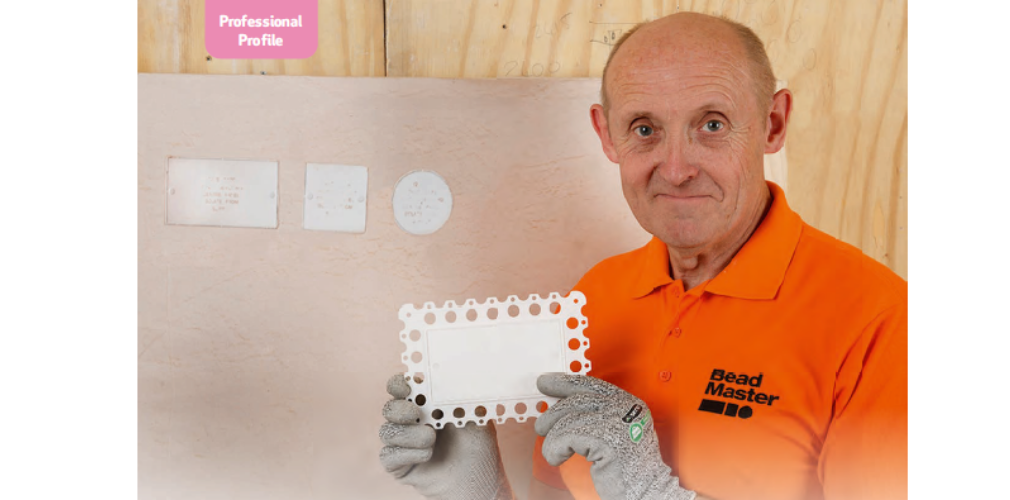We interview a plasterer turned electrician who invented an innovative new product designed to make life easier for both trades.
No-one can be a jack of all trades’. How often have we heard that term? While getting an expert to do an expert job is always good mantra, there are times when experience of more than one trade can provide an overall insight that will help bring a project to a successful conclusion more easily and timely.
Pete Carter, who followed in his family footsteps, changed career twice, and has now used the knowledge and experience gained from all his work life experiences to take on yet another role – as an inventor – is living proof of that theory.
“I have worked in all areas of the building trade,” said Pete, who is based in Southend-on-Sea. “My dad was a plastering subcontractor from the 1960s to 1980s, who employed 40-50
plasterers. My earliest memory is of being with him on a building site. I can recall being around building sites from the age of about four. At weekends and during school holidays I was always there with him.”
Following in his dad’s footsteps brought its own challenges and rewards. “My dad would not let me put plaster on a wall until I could lift a bag of cement over my head. I managed to do this when
I was about 12, so I started plastering then and by the time I left school, I was already plastering extensions,” said Pete.
Having joined the family business after leaving school, Pete lasted until he was 21 before he decided it wasn’t for him long-term. “I have basically got a short attention span. Once I’d learned something and felt I’d mastered it, I wanted to move on,” he said. “By that time I’d decided I no longer wanted to be a plasterer because I wasn’t as fast at it as my dad nor as good at it as my brother and I didn’t like being ‘average’!
“I had a change of direction and started building extensions when I was 21. I did the whole thing, from digging the footings to the brickwork.
Business grew and grew and at one point I had seven people working for me.” Then, in the late 1990s, as changes in P3 building regulations for electrics came into effect, he re-trained and qualified as an electrician which, he states, “is the only thing I’m actually qualified at”. He worked in various UK locations and it was during this third stage of his career, while working on a large
building in Leigh-on-Sea, that the inspiration for what was to become an award-nominated invention began to form in his mind.
Working on an 80m-plus ground floor area with more than 40 spotlights on one ceiling, which had to be perfectly aligned a metre apart, he considered some of the frustrations faced by
both electricians and plasterers during second and third fix.
“The structure of this ceiling made it very diffi cult to perfectly space the spotlights a metre apart, and there were fi re regulations to consider,” he said. “I came to the conclusion that I’d just have to drill them all out and put the wires in, but this left 40 holes in the ceiling that then needed to be plastered over. I thought to myself ‘there has to be an easier way’.”
A family man with three children and three step-children, Pete also decided at the age of 53, that he was tired of working six days a week and believed there had to be a way to minimise some of the stress resulting from his work.
The challenges created by spotlights with metal springs, holes that can be damaged during different fi xes, wires that can be difficult to locate following plastering, the impossibility of being able to pass a trowel over a spotlight hole and further potential damage if spotlights ever have to be removed following flooding, prompted Pete to develop his solution to all these problems 18 months ago.
While the practical solution for electricians is obviously for the holes to be drilled out prior to plastering, many plasterers understandably refuse to work with drilled-out surfaces because it can affect the standards of, and ease of completing, their own work. The plasterer’s preference is for the ceiling to be plastered and the hole cut out after. But, as Pete is keen to point out, this can create all manner of difficulties for the electrician if they have mismeasured even slightly and can result in damage to the new plaster finish.
“At this stage plasterers hate electricians and the electricians hate the plasterers – it’s a known fact!” Pete said. Pete invented Beadmaster, which enables a perfect fi nish to be achieved around sockets, switches, downlights and sprinklers and can reduce time on site by two to fi ve days, by cutting down on re-work and snagging. It consists of a plastic cover plate that is stapled to the
plasterboard, enabling plasterers to skim over socket, switch, downlight and sprinkler holes quickly and easily. The centre is then removed with a hooked blade which follows the groove of the Beadmaster to reveal smooth, rigid edges. After initially promoting the products through social media, Pete sold around 10,000 of the products between November 2018 and June 2019. He has since gone into partnership with FIS member Aask us Ltd, which manufactures profi les and trims for ceilings and partitions and began marketing the product last summer. The product is now
well regarded and recognised – so much so that it was nominated for the Innovative Product of the Year in both the Building Awards and London Construction Awards.


